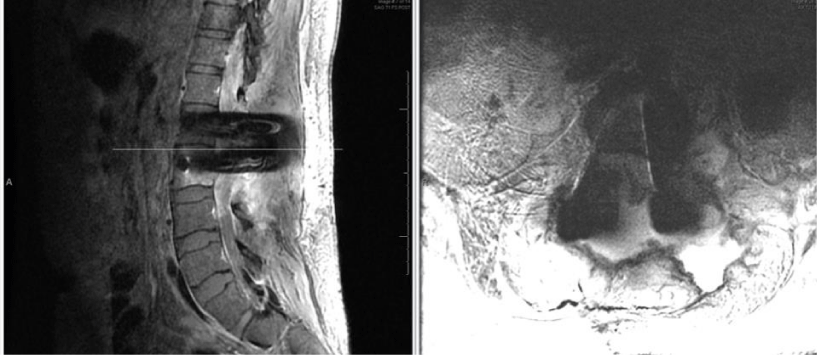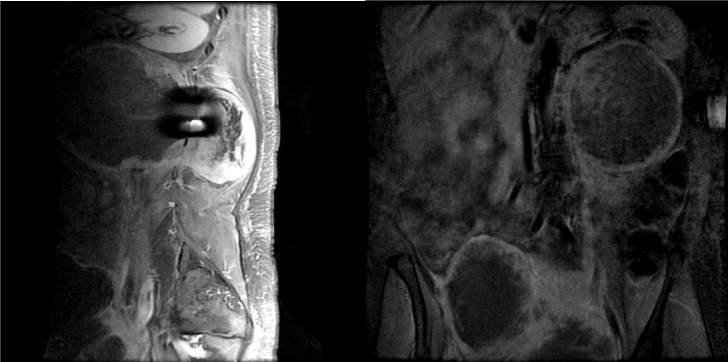Global Journal of Rare Diseases
A Case Report of a Malignant Triton Tumor of the Left Retroperitoneum in a Young Female Without Neurofibromatosis
Dayton Grogan BS, Vamsi Reddy BS*, Earl Dane Jones and Cargill H Alleyne
Cite this as
Dayton Grogan BS, Vamsi Reddy BS, Jones ED, Alleyne CH (2019) A Case Report of a Malignant Triton Tumor of the Left Retroperitoneum in a Young Female Without Neurofibromatosis. Glob J Rare Dis 4(1): 014-016. DOI: 10.17352/2640-7876.000016The authors report the case of a 37-year-old with a malignant triton tumor in the retroperitoneum. She presented with generalized pain that was worse in her left lower back and radiated down the left thigh and subsequently with progressive bilateral weakness and numbness in both legs. An MRI revealed the presence of a large mass within the left retroperitoneum and extending into the neural foramen and spinal canal at the L1-L2 level. The patient underwent surgical debulking of the tumor from the spinal canal and paraspinal musculature. However, one month after resection, the patient returned to the clinic with renewed bilateral numbness and weakness. MRI imaging showed recurrence of the original lesion with increased growth into the left paraspinal muscles and additional bilateral adnexal masses. Peritoneal metastasis to the ovaries and displacement of the left kidney were discovered. After a second resection, assessments revealed multiple recurrences of the original lesion. The patient’s health declined rapidly, and no further treatment was undertaken.
Introduction
Malignant peripheral nerve sheath tumors (MPNST) are malignant cancers with origins found within peripheral nerves of various body regions-most commonly involving the buttocks, thighs, brachial plexus and para-spinal region [1]. While MPNSTs account for only 5%-10% of all soft tissue sarcomas, there exist MPNST variations that occur with greater rarity [2]. Specifically, Malignant Triton Tumors (MTT) are a subset of MPNST with rhabdomyoblastic differentiation and account for only 5% of all MPNST cases [3]. MTTs were first described by Mason in 1932 and found to occur in patients with Neurofibromatosis type 1 (NF-1) in slightly more than 50% of cases. This is because sMTTs are believed to originate from Schwann cells of peripheral nerves or within existing neurofibromas [3,4]. Diagnosis of MTT is confirmed by immunohistochemical screening for desmin, vimentin, actin, myoglobulin, and S-100 protein.
Like MPNST, Malignant Triton Tumors appear most often in sites including the head, neck, extremities, and trunk [3]. However, sites such as the viscera, mediastinum, intracranium, and retroperitoneum are quite rare. Currently, there are less than 10 reported cases of retroperitoneal MTT in relevant literature [3,5]. The rarity of this condition and its clinical significance has prompted the reporting of this case.
Case Report
A 37-year-old African American woman, without a previous diagnosis of Neurofibromatosis type-1 (NF-1) presented with generalized pain that was worse in her left lower back and radiated down the left lateral/posterior thigh. Symptoms were treated with ibuprofen and valium. Two months before this initial visit, the patient’s records show normal blood work and lumbar X-ray scans, yet indicate a 60lb weight loss during the past eight weeks.
Approximately three weeks later, the patient presented again with progressive bilateral weakness and numbness in both legs. An MRI revealed the presence of a large mass within the left retroperitoneum and extending into the neural foramen and spinal canal at the L1-L2 level (Figure 1). This extension notably caused compression of the spinal cord and conus medullaris at these levels and slight exaggeration of the lumbar lordosis. She was transferred to Augusta University Hospital and scheduled for surgical debulking of the tumor from the spinal canal and paraspinal musculature (measuring 2.3cm AP ×1.7cm transverse ×2.5cm. craniocaudally after resection). As planned, the majority of the mass was maintained within the left retroperitoneum. Figure 2 shows MRI images obtained after the initial resection.
Subsequent pathology confirmed the presence of a malignant peripheral nerve sheath tumor with foci of rhabdomyoblastic differentiation (Malignant Triton Tumor). Nerve sheath differentiation of the spindle cells was further supported by positivity for S-100 protein in the majority of tumor cells as well as focal positivity for both desmin and myogenin [5]. Upon inspection, the tumor was classified as a grade 3 lesion in line with the Fédération Natrionale des Cenres de Lutte Contre le Cancer (FNCLCC) grading system [6].
Following resection, the patient showed signs of improvement with increased sensation and mobility of legs. However, one month after resection, the patient returned to the clinic with renewed bilateral numbness and weakness. MRI imaging showed recurrence of the original lesion with increased growth into the left paraspinal muscles (7cm. AP ×7.4cm. transverse ×7.9cm craniocaudally) and additional bilateral adnexal masses (Figure 3). Emergent resection and debulking of the paraspinal and intraspinal lesions were planned but rescheduled due to findings of peritoneal metastasis to the ovaries and displacement of the left kidney by the original retroperitoneal mass.
A second resection was eventually performed to debulk the tumor from the spinal canal and paraspinal regions in order to begin radiotherapy, as is consistent with the commonly recommended treatment for MTTs [2]. However, approximately two months after this second resection, assessments revealed multiple recurrences of the original lesion. The patient’s health declined rapidly after this point, and no further treatment was undertaken.
Discussion
Malignant triton tumors (MTT) belong to a category of malignant peripheral nerve sheath tumors (MPNST) with focal rhabdomyosarcomatous differentiation [7]. Diagnosis for Malignant Triton Tumors traditionally follows the three criteria [8], but has since adopted criteria based on more morphologic grounds including immunohistological staining and the presence of S-100 Protein Positivity [2]. The common morphological features are: (1) alternation of hypocellular and hypercellular regions with thin wavy, comma-shaped nuclei in the hypocellular areas, (2) the presence of nuclear palisading, (3) the presence of nerve whorls, (4) thick-walled vasculature and (5) the presence of rhabdomyoblasts and other heterologous elements such as cartilage and bone. Evidence of rhabdomyoblasts can be obtained through immunostains for proteins like desmin, myogenin, and myo-D1.
Triton Tumors, while only comprising approximately 5% of all MPNSTs, are highly aggressive with high rates of metastases (48%) and low overall survival rates (approximately 12%-26% for five-year survival). These statistics notably stem from the tumor’s low sensitivity to chemotherapy and radiation [4,5]. Like MPNSTs, common sites of occurrence for these tumors include the buttocks, thighs, brachial plexus and para-spinal region. Additionally, a significant proportion of MTTs coexist with NF-1 (44%-69%) and are associated with younger-aged males. NF-1 is an autosomal dominant disorder that is characterized by café au lait spots, colored bumps on the iris, and neurofibromas [4]. Sporadic occurrences of MTT do occur but appear more associated with females of older age after developing during an extended latent period of 10-20 years [2,5]. Despite this, the above case involves a relatively younger 37-year-old woman with a rare retroperitoneal MTT.
- Yaga US, Shivakumar R, Kumar MA, Sathyaprakash (2015) Malignant peripheral nerve sheath tumor: A rarity. Indian J Dent 6: 53-56. Link: https://tinyurl.com/yytjob3e
- Tripathy K, Mallik R, Mishra A, Misra D, Rout N, et al. (2010) A Rare Malignant Triton Tumor. Case Rep Neurol 2: 69-73. Link: https://tinyurl.com/y5xhpsus
- Ugwu JO, Onwukamuche ME, Ekwunife HO, JK CE, Modekwe V, et al. (2017) A Case of Retroperitoneal Malignant Triton Tumor in a Nigerian Boy. Niger J Surg 23: 141-144. Link: https://tinyurl.com/y58sp9h9
- Aykut B, Wieczorek K, Schirmacher P, Buchler MW, Hoffmann K (2016) A rare case of recurrent malignant triton tumor in a male with NF1: Case report and mini-review. Int J Surg Case Rep 21: 121-124. Link: https://tinyurl.com/y6cdqaek
- Li Z, Xiang J, Yan S, Gao F, Zheng S (2012) Malignant triton tumor of the retroperitoneum: a case report and review of the literature. World J Surg Oncol 10: 96. Link: https://tinyurl.com/yycvlmqk
- Coindre JM (1998) Histologic grading of adult soft tissue sarcomas. Verh Dtsch Ges Pathol 82: 59-63. Link: https://tinyurl.com/y4dbz42h
- Daimaru Y, Hashimoto H, Enjoji M (1984) Malignant "triton" tumors: A clinicopathologic and immunohistochemical study of nine cases. Hum Pathol 15: 768-778. Link: https://tinyurl.com/y3nxdus4
- Woodruff JM, Chernik NL, Smith MC, Millett WB, Foote FW (1973) Peripheral nerve tumors with rhabdomyosarcomatous differentiation (malignant "Triton" tumors). Cancer 32: 426-439. Link: https://tinyurl.com/y5peqf5b

Article Alerts
Subscribe to our articles alerts and stay tuned.
 This work is licensed under a Creative Commons Attribution 4.0 International License.
This work is licensed under a Creative Commons Attribution 4.0 International License.



 Save to Mendeley
Save to Mendeley
